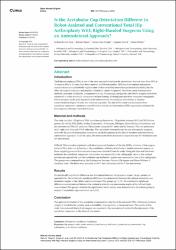| dc.contributor.author | Kara, Gökhan Kürşat | |
| dc.contributor.author | Turan, Kayhan | |
| dc.contributor.author | Eroglu, Osman Nuri | |
| dc.contributor.author | Öztürk, Çağatay | |
| dc.contributor.author | Ertuerer, Erden | |
| dc.date.accessioned | 2023-12-15T12:39:03Z | |
| dc.date.available | 2023-12-15T12:39:03Z | |
| dc.date.issued | 2023 | en_US |
| dc.identifier.citation | Kara, G. K., Turan, K., Eroglu, O. N., Ozturk, C., & Ertürer, E. (2023). Is the Acetabular Cup Orientation Different in Robot-Assisted and Conventional Total Hip Arthroplasty With Right-Handed Surgeons Using an Anterolateral Approach?. Cureus, 15(7), e42335. https://doi.org/10.7759/cureus.42335 | en_US |
| dc.identifier.uri | https://hdl.handle.net/20.500.12900/249 | |
| dc.description.abstract | Introduction Total hip arthroplasty (THA) is one of the most successful orthopaedic procedures. Survival rates from 90% at 10 years to 93% at 20 years have been reported in different studies. Differences in implant and patient characteristics can undoubtedly explain some of this variability observed in prosthesis durability, but the effect of surgical technique and implant orientation cannot be ignored. Therefore, many intraoperative methods (anatomic landmarks, intraoperative x-ray, fluoroscopy, navigation, and robotic surgery) have been attempted to avoid acetabular component malpositioning. Although postoperative computed tomography (CT) is accepted as the gold standard for the measurement of acetabular anteversion, it remains controversial in respect of costs and radiation exposure. The aim of this study was to examine how acetabular component orientation was affected in robotic and conventional THA operations performed by two surgeons with right-hand dominance. Material and methods The study included 113 primary THA operations performed on 113 patients between 2017 and 2022 in two groups: (i) robotic THA (Mako, Stryker Corporation, Kalamazoo, Michigan, United States) (55 patients) and (ii) conventional THA (58 patients). The patients comprised 51 males and 62 females. THA was performed on 54 right-side hips and 59 left-side hips. The operations were performed by two orthopaedic surgeons, each with 20 years of arthroplasty experience, on all the patients in the lateral decubitus position with an anterolateral approach. In all the cases, the orientation of the acetabular component was 40° inclination and 20° anteversion. Difficult THA procedures (patients with developmental dysplasia of the hip (DDH), a history of hip surgery, revision THA, defect or deformity of the acetabulum, a history of scoliosis or lumbar posterior surgery, or those requiring proximal femoral osteotomy) were excluded from the study. Using the Liaw and Lewinnek methods, the acetabular component anteversion was measured on the radiographs taken in the optimal position postoperatively and the acetabular cup inclination angles were measured on the pelvis radiographs. The groups were compared using the Kolmogorov-Smirnov, Pearson Chi-square and Mann-Whitney U statistical tests. The limits were accepted as 40±5° for inclination and 20±5° for anteversion. Results No statistically significant difference was determined between the groups in respect of age, gender, or operated side. No statistically significant difference was determined between the optimal acetabular cup inclination angles of the robotic and conventional THA groups (p = 0.79). No statistically significant difference was determined between the optimal acetabular cup anteversion angles of the left and right conventional THA groups. Statistically significantly better results were determined in the robotic group in respect of acetabular cup anteversion (p<0,001). Conclusion The optimal orientation of the acetabular component is a key factor for successful THA. Otherwise, revision surgery is inevitable for reasons such as instability, impingement, or increased wear. The results of this study demonstrated that robotic surgery was superior to the conventional method in the placement of the acetabular component in the desired orientation. | en_US |
| dc.language.iso | eng | en_US |
| dc.publisher | Cureus Inc | en_US |
| dc.relation.isversionof | 10.7759/cureus.42335 | en_US |
| dc.rights | info:eu-repo/semantics/openAccess | en_US |
| dc.subject | Asetabular kap anteversiyonu | en_US |
| dc.subject | Acetabular cup anteversion | en_US |
| dc.subject | Asetabular kap eğimi | en_US |
| dc.subject | Acetabular cup inclination | en_US |
| dc.subject | Yapay zeka ve robotik | en_US |
| dc.subject | Ai & robotics | en_US |
| dc.subject | Sağlık hizmeti | en_US |
| dc.subject | Healthcare | en_US |
| dc.subject | Kalça artroplastisi | en_US |
| dc.subject | Hip arthroplasty | en_US |
| dc.subject | Kalça ameliyatı | en_US |
| dc.subject | Hip surgery | en_US |
| dc.subject | Mako | en_US |
| dc.subject | Robot destekli | en_US |
| dc.subject | Robot-assisted | en_US |
| dc.title | Is the Acetabular Cup Orientation Different in Robot-Assisted and Conventional Total Hip Arthroplasty With Right-Handed Surgeons Using an Anterolateral Approach? | en_US |
| dc.type | article | en_US |
| dc.department | İstanbul Atlas Üniversitesi, Tıp Fakültesi, Cerrahi Tıp Bilimleri Bölümü | en_US |
| dc.authorid | Kayhan Turan/ 0000-0002-2058-6534 | en_US |
| dc.contributor.institutionauthor | Turan, Kayhan | |
| dc.identifier.volume | 15 | en_US |
| dc.identifier.issue | 7 | en_US |
| dc.relation.journal | Cureus, Journal of Medical Science | en_US |
| dc.relation.publicationcategory | Makale - Uluslararası Hakemli Dergi - Kurum Öğretim Elemanı | en_US |

















